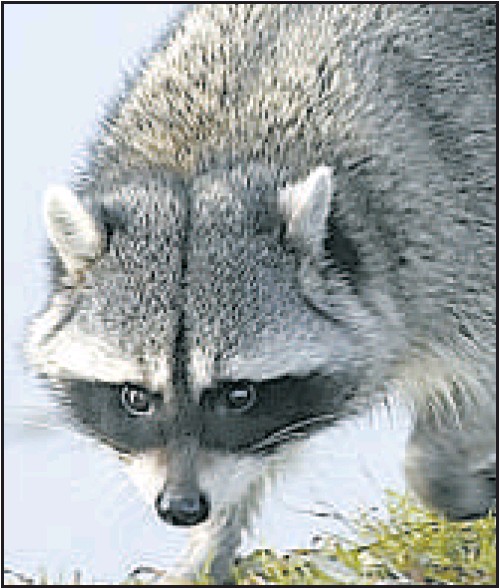Attics appeal to females set to give birth
Elaine O’Connor
Province

RACCOON – PROVINCE FILE PHOTO
It’s spring and a young raccoon’s thoughts turn to nesting — in your attic.
It’s birthing season for raccoons, which have litters of three to five kits in April and May — and pest-control companies say that as noises in the attic rise, so do calls.
“There are a lot of them around and they’re looking to have babies,” Jamie Kiffiak of North Shore Pest Detective said of the wily rodents.
Kiffiak said an outbreak of canine distemper killed a large swath of the population in 1997, but since then they’ve been slowly building up their numbers. In the interim, skunks faced less competition and are now thriving as well.
Raccoons den up high in hollow trees, attics and such, while skunks prefer spots under decks and sheds.
“We’re getting lots of calls from people who hear noise in their attic or have a hole in their roof, especially if they have
terracotta or cedar shakes,” said Kiffiak, who owns a Tri-Cities Pest Detective.
Brett Johnston, operations manager of the Coquitlam-based Canadian Pest Control Ltd., said he hasn’t seen a population boom, just the steady seasonal boom.
“Every pest has a season and this is just their time of year,” Johnston said.
These pests can be destructive.
“A raccoon is quite a strong animal, and when they are
driven to give birth safely, they can easily make a hole to get in your home,” he said.
Raccoons can be scared away by introducing a predator’s scent such as coyote urine, evicting the mother and babies, or trapping and relocating them to a wilderness area.
Leaving them to mature and leave the attic encourages the mother and pups to return in future years.
The animals are also known to be carriers of disease such as rabies, canine distemper, encephalitis and mange, and infested with roundworms, fleas, ticks and lice, so it’s not advisable for homeowners to try and flush them out on their own.
Better to work on prevention.
Johnston suggests removing tree branches and other structures that could provide animals access to roofs, fastening garbage cans, getting rid of freshwater sources and not leaving any food such as ripe tree fruit or garden vegetables outside.
Otherwise, Johnston warns, “they’ll make your home part of their territory.”
He’s even had calls about raccoons coming in pet doors to eat the cat’s kibble, sometimes taking up residence if owners aren’t home.
While pest companies do good business in raccoon and skunk control each spring, its not everyone’s favourite job.
“It’s a really tough one when you have six or eight skunklings running around and they can all spray . . . it doesn’t pay to be too aggressive with skunks,” Kiffiak said.
© Copyright (c) The Province

